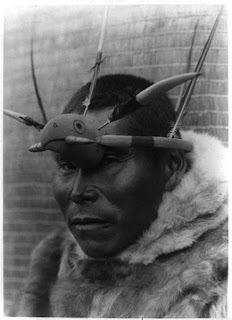Reading Notes- Alaska Legends Unit- Part A&B
Part A-
Part B-
Well, I am currently gushing over how sweet just the first
story is! To say it is coincidental with the biblical versions of the creation
of man and animals would be an understatement. The metaphorical use of clay
sculptures was amazing to me. For example “he sculpted the clay into a deer,
but did not let it fully dry, so the deer came out brown with white spots.” I
just thought that it was incredibly sweet to read. What I was not expecting in
these stories however, was the depiction of the Raven as a sort of God. In the
description, it mentions the ‘trickester raven’ so I imagined coming into
something like an Anansi story. What I found however was quite the opposite. In
the stories, the Raven guides the people. The Raven teaches man which animal is
which, which ones he should kill and eat, how to kill them, and which ones he
should be fearful of. The figure of the Raven is obviously very symbolic, as he
is essentially the leader of everything and everyone else. I knew that Native
American stories are historically and traditionally very symbolic before
beginning this reading, but I see now how they sneak different aspects of life
into their stories. The whole time as the Raven and the Man were flying about,
seeing different parts of the world, the Man’s wife and children aged while he
did not. So it became apparent that the reality of time does not apply to the
Raven and the Man. They speak of ‘flying’ above others and living in the
‘skyland’, which I see now are metaphors for the fact that the Raven and Man
are spiritual beings, in charge of balance and order of other things. It is
probably just me, but I am a sucker for stories that have explanations for why
things are the way they are. For example, when they visit the ‘groundhog
people’ who know when the snow is going to fall, which means that spring is
coming, that is so cool!!
Bibliography: Katharine Berry Judson, Myths and Legends of Alaska, Alaskan Legends Unit
There is an aspect of storytelling that I have always been
intrigued by, and secretly hoped I could master one day, and this is
introducing a concept or a symbol early on into a story, and finding a way to
incorporate that same idea later on in the story, leaving the readers with a
“oh wow, that’s what that meant” moment. Maybe because I have become enthralled
with idea of witty story telling, I notice things like this more and more. I
can definitely say as we have moved through this semester, and now this unit, I
have become 110% more appreciative of what it takes to write a story, and for
it to make sense all that way through at that! The story, the Land of the Dead,
was so interesting to me, and symbolic at that. For example, in the story, the
young girl comes to a river made up of the tears that people on earth weep for
those who have died. And the only way you can cross this river is if you too
cry, and then a canoe appears. This canoe takes you across a bridge, and you
make it to the other side. I think that is such a beautiful way of depicting
how us as humans grieve, and the natural way we should handle it to overcome
it.
Bibliography: Katharine Berry Judson, Myths and Legends of Alaska, Alaskan Legends Unit




Comments
Post a Comment